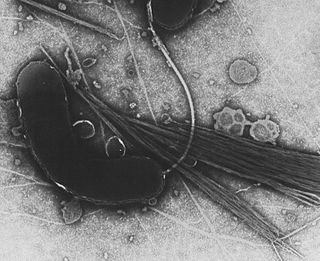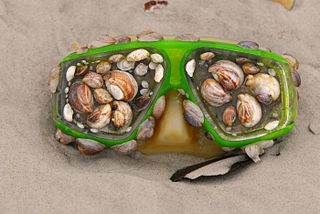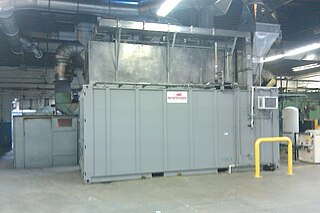A xenobiotic is a chemical substance found within an organism that is not naturally produced or expected to be present within the organism. It can also cover substances that are present in much higher concentrations than are usual. Natural compounds can also become xenobiotics if they are taken up by another organism, such as the uptake of natural human hormones by fish found downstream of sewage treatment plant outfalls, or the chemical defenses produced by some organisms as protection against predators.

Bioremediation broadly refers to any process wherein a biological system, living or dead, is employed for removing environmental pollutants from air, water, soil, flue gasses, industrial effluents etc., in natural or artificial settings. The natural ability of organisms to adsorb, accumulate, and degrade common and emerging pollutants has attracted the use of biological resources in treatment of contaminated environment. In comparison to conventional physicochemical treatment methods bioremediation may offer considerable advantages as it aims to be sustainable, eco-friendly, cheap, and scalable. Most bioremediation is inadvertent, involving native organisms. Research on bioremediation is heavily focused on stimulating the process by inoculation of a polluted site with organisms or supplying nutrients to promote the growth. In principle, bioremediation could be used to reduce the impact of byproducts created from anthropogenic activities, such as industrialization and agricultural processes. Bioremediation could prove less expensive and more sustainable than other remediation alternatives.

Pseudomonas putida is a Gram-negative, rod-shaped, saprophytic soil bacterium. It has a versatile metabolism and is amenable to genetic manipulation, making it a common organism used in research, bioremediation, and synthesis of chemicals and other compounds.

Burkholderia is a genus of Pseudomonadota whose pathogenic members include the Burkholderia cepacia complex, which attacks humans and Burkholderia mallei, responsible for glanders, a disease that occurs mostly in horses and related animals; Burkholderia pseudomallei, causative agent of melioidosis; and Burkholderia cepacia, an important pathogen of pulmonary infections in people with cystic fibrosis (CF). Burkholderia species is also found in marine environments. S.I. Paul et al. (2021) isolated and characterized Burkholderia cepacia from marine sponges of the Saint Martin's Island of the Bay of Bengal, Bangladesh.

Geobacter is a genus of bacteria. Geobacter species are anaerobic respiration bacterial species which have capabilities that make them useful in bioremediation. Geobacter was found to be the first organism with the ability to oxidize organic compounds and metals, including iron, radioactive metals, and petroleum compounds into environmentally benign carbon dioxide while using iron oxide or other available metals as electron acceptors. Geobacter species are also found to be able to respire upon a graphite electrode. They have been found in anaerobic conditions in soils and aquatic sediment.

Gammaproteobacteria is a class of bacteria in the phylum Pseudomonadota. It contains about 250 genera, which makes it the most genus-rich taxon of the Prokaryotes. Several medically, ecologically, and scientifically important groups of bacteria belong to this class. It is composed by all Gram-negative microbes and is the most phylogenetically and physiologically diverse class of Proteobacteria.
Paraburkholderia fungorum is a Gram-negative species of bacteria. that has been commonly used as a beneficial microorganism in agriculture as an agent for biocontrol and bioremediation. Paraburkholderia fungorum is Some of its strains can use uranium for their growth and convert U(VI) to U(IV).
Paraburkholderia phymatum is a species of bacteria that is capable of symbiotic nitrogen fixation with the legumes Machaerium lunatum and Mimosa pudica. Recently, the genome was sequenced. It consists of two chromosomes, a megaplasmid, and a plasmid hosting the symbiotic functions.

In taxonomy, Roseobacter is a genus of the Rhodobacteraceae. The Roseobacter clade falls within the {alpha}-3 subclass of the class Alphaproteobacteria. The first strain descriptions appeared in 1991 which described members Roseobacterlitoralis and Roseobacterdenitrificans, both pink-pigmented bacteriochlorophyll a-producing strains isolated from marine algae. The role members of the Roseobacter lineage play in marine biogeochemical cycles and climate change cannot be overestimated. Roseobacters make up 25% of coastal marine bacteria and members of this lineage process a significant portion of the total carbon in the marine environment. Roseobacter clade plays an important role in global carbon and sulphur cycles. It can also degrade aromatic compounds, uptake trace metal, and form symbiotic relationship. In term of its application, Roseobacter clade produces bioactive compounds, has been used widely in aquaculture and quorum sensing.
Microbial biodegradation is the use of bioremediation and biotransformation methods to harness the naturally occurring ability of microbial xenobiotic metabolism to degrade, transform or accumulate environmental pollutants, including hydrocarbons, polychlorinated biphenyls (PCBs), polyaromatic hydrocarbons (PAHs), heterocyclic compounds, pharmaceutical substances, radionuclides and metals.
Metaproteomics is an umbrella term for experimental approaches to study all proteins in microbial communities and microbiomes from environmental sources. Metaproteomics is used to classify experiments that deal with all proteins identified and quantified from complex microbial communities. Metaproteomics approaches are comparable to gene-centric environmental genomics, or metagenomics.
Alcanivorax borkumensis is an alkane-degrading marine bacterium which naturally propagates and becomes predominant in crude-oil-containing seawater when nitrogen and phosphorus nutrients are supplemented.
Paraburkholderia oxyphila is a gram-negative, aerobic, non-spore-forming, non motile, rod-shaped bacterium from the genus Paraburkholderia and the family Burkholderiaceae which was isolated from acidic forest soil.
Paraburkholderia rhizoxinica is a gram-negative, oxidase and catalase-positive, motile bacterium from the genus Paraburkholderia and the family Burkholderiaceae which was isolated from the plant pathogenic fungus, Rhizopus microsporus. The complete genome of Paraburkholderia rhizoxinica is sequenced.
Paraburkholderia sartisoli is a gram-negative, aerobic catalase and oxidase-positive rod-shaped bacterium from the genus Paraburkholderia and the family Burkholderiaceae which was isolated from polycyclic aromatic hydrocarbon contaminated soil in New Zealand.

The plastisphere consists of ecosystems that have evolved to live in human-made plastic environments. All plastic accumulated in marine ecosystems serves as a habitat for various types of microorganisms, with the most notable contaminant being microplastics. There are an estimate of about 51 trillion microplastics floating in the oceans. Relating to the plastisphere, over 1,000 different species of microbes are able to inhabit just one of these 5mm pieces of plastic.

A biological oxidizer is a device that uses micro-organisms to treat wastewater and the volatile organic compounds produced by commercial and industrial operations. Biological oxidation devices convert biodegradable organic compounds into carbon dioxide and water. This is a natural occurring process which differs from traditional chemical and thermal oxidizing agents and methods. Some of the more commonly used micro-organisms are heterotrophic bacteria, which play an important role in biological degradation processes. Generally, these micro-organisms are rod shaped and facultative. Biological oxidizers provide a stable environment which allows bacteria to naturally oxidize and stabilize a large number of organics in a more efficient manner. Some of the emissions that may be treated biologically include:
Paraburkholderia is a genus of Pseudomonadota that are gram negative, slightly curved rods that are motile by means of flagella. They have been reported to colonize endophytic tissues of hybrid spruce and lodgepole pine with a strong potential to perform biological nitrogen fixation and plant growth promotion. Unlike Burkholderia species, Paraburkholderia members are not commonly associated with human infection. Paraburkholderia members form a monophyletic clade within the Burkholderiaceae family, which is what prompted their distinction as a genus independent from Burkholderia species, in combination with the finding of robust conserved signature indels which are unique to Paraburkholderia species, and are lacking in members of the genus Burkholderia. These CSIs distinguish the genus from all other bacteria. Additionally, the CSIs that were found to be shared by Burkholderia species are absent in Paraburkholderia, providing evidence of separate lineages.
Metallosphaera hakonensis is a gram-negative, thermoacidophilic archaea discovered in the hot springs of Hakone National Park, Kanagawa, Japan.
Hydrocarbonoclastic bacteria are a heterogeneous group of prokaryotes which can degrade and utilize hydrocarbon compounds as source of carbon and energy. Despite being present in most of environments around the world, several of these specialized bacteria live in the sea and have been isolated from polluted seawater.







